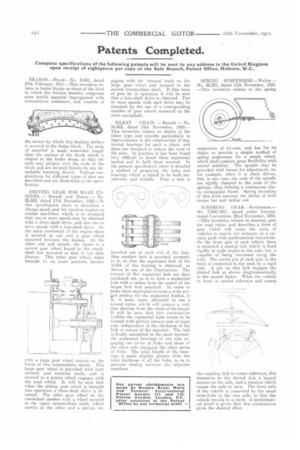Patents Completed.
Page 24

If you've noticed an error in this article please click here to report it so we can fix it.
Complete specifications of the following patents will be sent to any address in the United Kingdom upon receipt of eightpence per copy at the Sate Branch, Patent Office, Holborn, W.C.
BRAKES.—Frood.—No. 4,835, dated 27th February, 1911.—This invention relates to brake blocks or shoes of the kind in which the friction member comprises some textile material impregnated with cementitious substance, and conaists of the means by which this braking surface is secured to the brake block. The strip of material is made somewhat longer than the surface of the block which is shaped to the brake drum, so that the ends may project over the ends of the block and are secured thereto by any detachable fastening device. Various constructions for different types of shoe are described and are illustrated in the speci fication.
DRIVING GEAR FOR ROAD ENGINES. — Burrell and Duran. — No. 29,382, dated 17th December, 1910.—In this specification there is described a change-speed gear for traction engines or similar machines, which is so arranged that one or more speeds may be obtained with a three-shaft drive, arid also one or more speeds with a four-shaft drive. On the main crankshaft of the engine there is secured at one end a gear wheel mounted between the frames. At the other end and outside the frame is a second gear wheel keyed to the crankshaft but mounted so that it can slide thereon. This latter gear wheel, when brought to its inner position, meshes
with a large gear wheel carried on the lower of two intermediate shafts. This large gear wheel is provided with both internal and external teeth, and is secured to a pinion which engages with the road wheel. It will be seen that when the sliding gear wheel is brought into operation a three-shaft drive is obtained. The other gear wheel on the crankshaft meshes with a wheel secured to the upper intermediate shaft, which carries at the other end a pinion, en gaging with the internal teeth on the large gear wheel and secured to the second intermediate shaft. If this train of gear -be in operation it will be seen that a four-shaft drive is obtained. Two or more speeds with each drive may be obtained by the use of a corresponding number of gear wheels mounted on the main crankshaft.
SILENT CHAIN. —Renold. — No. 26,805, dated 18th November, 1910.— This invention relates to chains of the silent type and consists particularly in improvements in the construction of segmental bearings for such a chain, and these are designed to reduce the wear of the pins. In practice it has been found very difficult to insert these segmental bushes arid to hold them secured. In the present specification there is detailed a method of preparing the links and bearings which is stated to be both satisfactory and reliable. First a hole is
punched out at each end of the link, then another hole is punched eccentric to it, so that the segmental hole of the width of the bearing is obtained, as shown in one of the illustrations. The corners of this segmental hole are then machined out, so as to form a segmental hole with a radius from the centre of the larger hole first punched. In order to make these segmental recesses a more perect seating for the segmental bushes, it is, in some cases, advisable to use a second cutter which will remove a very thin shaving from the whole of the recess. It will be seen that this construction eaables the segmental bush recess to be formed with perfect corners and of exact size, independent of the thickness of the link or nature of the material. The link is finally assembled in the usual manner. the segmental bearings of one side engaging one series of links and those of the other side engaging the other series of links. The total length of the bearings is made slightly greater than the total thickness of all the links, so as to prevent chafing between the adjacent members.
SPRING SUSPENSION.—Vs'eller.— No. 26,291, dated 11th November, 1910. —This invention relates to the spring suspension of tri-cars, and has for its object to provide a simple method of spring suspension for a single wheel, which shall combine great flexibility with lateral stability. The spindle may be provided with means for adjustment, as, for example, when it is chain driven, but, in any case, the ends of the spindle are rigidly clamped to the ends of the springs, thus forming a continuous elastic rectangular frame. Spring mounting of this kind assumes the duties of both torque bar and radius rod.
STEERING GEAR.—Forthmann.— No. 7,662/1911. dated under International Convention, 22nd November, 1910. —This invention relates to steering gear for road trains and describes a form of gear which will cause the train of vehicles to travel, for instance, in a circular path with mathematical exactitude. On the front axle of each vehicle there is mounted a slotted link which is fixed rigidly at right angles to the axle, hut is capable of being traversed along the .axle. The centre pin of each axle in the train is connected to the next by a rigid link. A pin on this link engages the slotted link As shown diagrammatically in the second figure. When the vehicle in front is turned eideways and causes the coupling link to rotate sideways, this transmits to the slotted link a lateral motion on the axle, and a rotation which causes the axle to turn. The front axle of the vehicle is connected by the usual cross-links to the rear axle, so that the vehicle travels in a circle A mathematical proof is given that this construction gives the desired effect
























